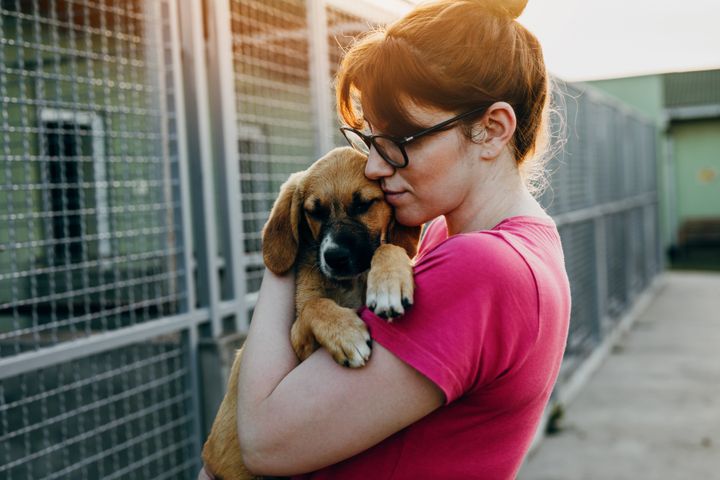The loss of a beloved pet is a profoundly emotional experience, leaving an indelible void in the lives of those who cherished their four-legged companions. The bonds we share with our animals are woven with memories, laughter and the unspoken language of unconditional love.
As the inevitable cycle of life takes its course, some owners are faced with a profound question: How long should one wait after losing a pet to welcome another into their heart and home?
“Grieving takes a lot of mental, physical, and emotional energy ― and so does bonding with a new pet,” Judith Harbour, a veterinary social worker at Schwarzman Animal Medical Center in New York City. “If a person is not ready, they might not have emotional space for the new pet or for grieving the one who died. This can complicate grief and make it difficult to continue adjusting to the loss.”
She added that bonding with a new animal companion is challenging if you don’t have enough emotional bandwidth. Jennifer Breslow, a psychotherapist who specializes in pet loss counseling, similarly noted that grieving pet owners might feel as though they are betraying their late pet by forming a new relationship with another animal before they’ve adequately grieved.
“The death of a pet is a devastating loss and people often feel overwhelmed by the emptiness and void they feel when their pet is gone,” she said. “The impulse to fill that hole can be strong, and it might be tempting to quickly get a new pet to fill it and avoid the pain and sadness that comes with grief. But this isn’t fair to you or the new pet. If a new pet is brought home too soon, you may start having feelings of resentment that this new pet acts in different ways or has a different personality than the pet that passed.”
So when is the right time to bring another pet into your life after losing a beloved furry friend? How can you know you’ve reached that point? And what’s the best way to work through your grief? Harbour, Breslow and other experts share their advice below.
Understand there’s no set timeline.
“The amount of time to wait after losing a pet to bring another one into your life is going to be different for everyone,” Breslow said. “Generally though, the right time is when you have adequately grieved and processed the loss of the first pet.”
Some pet owners might feel ready to embrace a new animal companion after a matter of days, while others wait years. It’s a highly personal process with no set timeline.
“The length of time to move through grief varies for every person, but in my experience it’s more likely to be several months rather than weeks,” Breslow added. “Our culture doesn’t really acknowledge how significant a loss it can be to lose a pet. So sometimes there is a tendency for well-meaning people ― especially those who may not have had their own experience with the human-animal bond — to suggest getting a new pet as a way to move forward from the loss. You don’t need to listen to them.”
While it’s true that the companionship of new pet can help with the healing process, only you will know when you’re ready to take that step.
“So really check in with yourself and make sure you have allowed yourself the time and space to adequately grieve,” Breslow said. “Remember that grieving is a process that takes time and is filled with a mess of uncomfortable feelings. But it is temporary and a normal human response to a significant loss.”
Allow yourself to feel and process your grief.
“Grief doesn’t have a timetable, unfortunately, and while each loss is unique to the shared relationship, there are stages of grief for pet loss just like there are for humans,” said Colleen Rolland, a pet loss grief specialist at the Association for Pet Loss Bereavement.
She pointed to the work of APLB founder Wallace Sife, who identified five stages of pet grief: 1. Shock, disbelief and denial. 2. Anger, distancing and alienation. 3. Guilt. 4. Depression. 5. Resolution.
“By becoming aware of the stages, people are provided with a valuable ‘road map’ of what to expect as they navigate their grief journey,” Rolland said, noting that the framework helps normalize painful emotions. “But each person experiences them in a unique and personal manner.”
You might be able to move through the stages more quickly if you were able to say goodbye to your animal after a prolonged period of decline and anticipatory grief versus losing them in a sudden accident.
“The most important piece to consider is being intentional in your grief,” said Jennifer Scanlon, a social worker at VCA South Shore (Weymouth) Animal Hospital. “Allowing ourselves to feel the emotions surrounding our grief can put us on a path to healing. Granting yourself permission to heal will open your heart to the possibility of a new pet when you feel ready.”
Wait until you can think of your late pet without feeling overwhelmed with painful emotions.
“An indicator that you may be ready for a new pet is that you are able to embrace memories of your previous pet without intense sadness and guilt,” Scanlon said. “We truthfully do not ‘get over’ the losses of our companion animals, but with time, the intensity of the grief will lessen. When we learn how to incorporate this grief into our lives, we can find ways to move forward with cherished memories and know when we are ready to love another animal.”
Ask yourself if you can talk about your deceased pet without feeling overwhelmed with pain and sadness. When you close your eyes and think of them, can you conjure joyful memories and keep breathing ― or do you immediately want to cry and feel stress in your body?
Rolland advised waiting until you can think about your beloved pet and “smile ― even laugh ― at some of their crazy antics or wonderful times you shared.”
Ask how you feel when you imagine welcoming a new pet into your life.
Similarly, examine how the thought of welcoming a new pet into your life makes you feel.
“When people are not ready, they often have a viscerally negative reaction to the idea of adopting another pet, especially when encouraged to do so by people they perceive as minimizing their grief,” Harbour said. “For others, when they are not ready, the thought does not even cross their mind, even if they know in their heart that there is another pet in their future. Many people start to tiptoe into contemplating this question once their acute grief has waned. They may try imagining what it would be like bringing a new animal companion home.”
In these moments, it’s useful to consider why you might want a new pet and whether you feel happy and excited at the prospect. See how you feel when you interact with friends’ pets.
“A marker that you are ready might be when the idea of a new pet doesn’t feel like a betrayal, but more like an exciting new relationship,” Breslow said.
Make sure you don’t have unfair expectations.
“Make sure your expectations of a new pet are realistic,” said Camp Bow Wow animal health and behavior consultant Erin Askeland. “Too often people hope to find a replacement, a replica, a new pet that mimics what they’ve lost, and the truth of the matter is, that’s not likely to happen. Each pet is an individual, and even if you get the same breed, age, size or general temperament, the pet is still likely to have a completely different personality than the pet you’ve lost.”
Understand that the relationship you develop with a new pet won’t be the same as the one you had with your late pet. Be prepared to embrace their individuality and cherish the new bond you will forge ― rather than expecting an exact replacement.
“This mindset can lead to heartache for you as you may become upset and even resentful of the new dog when they are different,” Rolland said. “Also, it’s not fair to the new pet who deserves your complete love and attention. Make sure that you are ready, and the timing is right.”
Group4 Studio via Getty Images
Consider if your lifestyle is suited to bringing a new pet home.
“People should consider finances and other practical matters such as their own health, age and living situation,” Harbour said. “If time has gone by since having a pet, some of these circumstances may have changed. People should consider the other members of the household ― both human and animal. All the humans should be aligned with bringing home a new pet.”
If you have other pets, ask if their age, health situation and temperament would be compatible with a new housemate. You also might want to take time to recover from an intense period of caregiving if your deceased pet was in poor health at the end of their life.
“Consider the reasons you want to get another pet and if you’re ready to make that emotional, financial and physical commitment to their care and well-being,” Askeland said. “It’s important to know yourself well and understand your own needs. After losing my ‘soul’ dog, it took almost three years before I was mentally prepared to take on another dog ― and that was right for me.”
Don’t forget to memorialize your lost pet.
“Rituals are helpful ways for people to process grief,” said Carolyn Gartner, a grief counselor in New York City. “A short memorial for the pet, photos, lighting a candle or a dinner where family can share what they loved and miss about the pet, all support healing.”
Consider inviting all your friends and other loved ones who knew your pet or want to support you.
“There are many forms of grief that are completely normal in the wake of the loss of a beloved pet,” said Eileen Hanavan, director of volunteer and foster engagement at the ASPCA Adoption Center. “It can help to memorialize your pet in a way that includes others who cared about them.”
Younger kids might benefit from having a photo of their lost pet, perhaps one that they’re in as well.
“Print it out with a border so the child can draw, color or decorate around the photo,” Gartner advised. “Frame it and put it on the shelf. If parents feel comfortable, when a new pet is brought in, the child can ‘introduce’ the new pet to the old one ― ‘We love that kitty and we love our new one too!’”
Reach out for support.
“‘Just replacing’ a pet doesn’t actually integrate the loss,” Gartner said. “This is the goal of healthy grieving, to integrate the loss into our hearts. This means that we accept the loss and remember the loved one from a grounded, loving place and not with acute grief feelings, which include separation distress, shock or yearning for an answer.”
She emphasized the importance of paying attention to severe symptoms and consulting with a professional if you’re struggling to cope for an extended time. There might be underlying issues, like an earlier death that you never fully processed.
“The loss of a pet also can feel ‘like a pile on’ to non-finite losses (non-death loss) ― ‘I lost my job and now and this!’” Gartner said. “Pet loss can also challenge someone’s attachment style if it’s not secure; adults with abusive or absent parents finally got the love and security they longed for from a loyal animal. Now that the loving presence is gone, it transports them back to the fear, pain or isolation they experienced as a child. There is lots of support out there.”
You might find comfort in a talking about your feelings with loved ones, a trained counselor or even a support group.
“Pet loss support groups can be powerful healing environments to help you process the loss and be able to share similar emotions and experiences in the grief journey with others,” Scanlon said. “Grieving a loss, particularly a pet loss, can be isolating, and a pet loss support group allows you to talk with others who understand the animal/human bond.”
Remember you can connect with animals in other ways before adopting another.
Even if you aren’t ready to bring a new pet creature your life, pets can help you move through your mourning process in other healthy ways.
“Certainly, animals can bring comfort while you are grieving, so if that is something that feels helpful to you, consider spending time with friend’s pets or volunteering at an animal shelter before making the commitment to bring a new pet home,” Breslow advised.
Reach out to your local shelter and find out how you might help animals in need as a way to work through your emotions and honor your lost pet’s memory. Hanavan noted that volunteer opportunities might involve spending time with animals, assisting with laundry or kennel cleaning, doing administrative tasks, spreading the word about available animals on social media or donating items like pet food or towels.
“Getting involved as a foster caregiver can be a wonderful way to ease back into the joy, comfort, and companionship that life with a pet can bring,” she added. “Foster periods vary and can range from a few days to a few weeks, or even several months — it depends on the individual animal’s needs. Both adoption and fostering places shelter animals in safe and loving homes, helps shelters conserve their space and resources, and provides people with comfort and companionship.”
Over time, your fostering work might even turn into a pet adoption. When the time is right, don’t reject the opportunity to offer your care, protection and love to another animal.
“It would be a tragedy not to pursue the happiness that another relationship would bring, even though we go into it with our eyes wide open knowing that we will be gutted again when that cycle of life comes to an end,” Rolland said. “Rather than fear it and be saddened by it, we should re-frame it to view it as one of the very best gifts that life can offer ― an unconditional love with an animal companion.”


